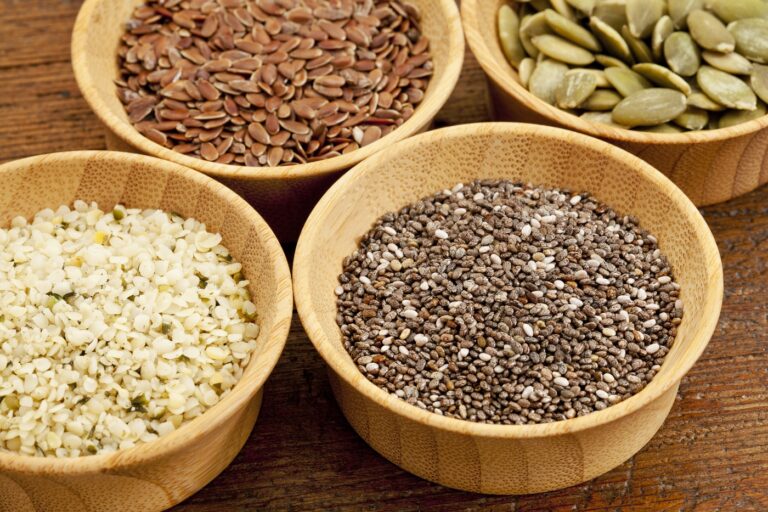One of the very first Nutrition Diva podcast episodes, back in 2008, was on the nutritional benefits of flaxseeds. Among other things, flaxseeds are a good source of omega-3 fatty acids, which is helpful for folks who don’t eat fish. At the time, flaxseeds were more or less alone in that category. Since then, however, two new omega-3-rich seeds have exploded onto the scene. I’ve gotten lots of questions from you about chia and hemp seeds and how they compare with flax. So today, we’re going to have a seed showdown to see how these various seeds stack up.
What Do Flax and Chia Have in Common?
Flax and chia are fairly similar nutritionally. Both are excellent sources of omega-3, each providing about 2400 mg of omega-3s per tablespoon. Both are also high in fiber, with chia having the edge—5 grams of fiber per tablespoon versus 3 grams for flax. Both also contain a modest amount of protein.
What Are the Differences Between Flax and Chia?
Flaxseeds are particularly rich in lignans, compounds that seem to provide extra protection against many types of cancer—a benefit that chia does not provide. On the other hand, flaxseeds have a hard shell and must be ground or thoroughly chewed in order for their nutrients to be absorbed. Tiny chia seeds do not have this protective armor and are readily digested without grinding.

How Does Hemp Compare with Flax and Chia?

Hemp also isn’t as high in omega-3s. Flax and chia both provide about 2400 mg of omega-3 per tablespoon, while hemp only provides about 1000 mg. In addition, hemp is also much higher in omega-6. Flax and chia both provide about three times as much omega-3 as omega-6. With hemp, the ratio is reverse: about 3 times as much omega-6 as omega-3.
As I’ve talked about before, in order to get the most benefit from omega-3 (especially from plant-based sources), you need a balance between omega-6 and omega-3 fats in your diet. In general, our diets tend to be much higher in omega-6 than omega-3. And that’s what makes foods like flax and chia (as well as fish) so valuable: They provide a lot of omega-3 and not very much omega-6. Hemp, on the other hand, provides a lot of omega-3 but a whole lot more omega-6. So, as a way to balance the omegas in your diet, hemp is not as useful.
Big Difference in Price
Here’s one thing chia and hemp have in common: They are both considerably more expensive than flax. You can buy flaxseed in bulk for $1.99/lb. Chia costs about $10 a pound and hemp will set you back about $12 a pound. Hopefully, these higher-ticket seeds will come down in price as supply catches up with demand.
| 1 Tablespoon |
Flax |
Chia |
Hemp |
| Total Fat |
4.5 |
4 g |
4.6 |
| Omega-3s |
2300 mg |
2400 mg |
1000 mg |
| Omega-6 |
600 mg |
800 mg |
2500 mg |
| Protein |
2 g |
2.5 g |
3.5 |
| Fiber |
3 g |
5 g |
0.3g |
| Calories |
55 |
60 |
57 |
| Price |
.05 |
.22 |
.26 |
How Do They Taste?
In terms of taste and texture, flax, chia, and hemp are all completely unique. Flaxseeds, which are a bit larger than sesame seeds, are hard and rather dry, with a faint grassy taste that gets nuttier when you toast them.
Chia seeds are much smaller and rather neutral in flavor—similar to poppy seeds. When exposed to water, they form a slippery gel with a slight crunch.
Hemp seeds, which are generally sold hulled, have a taste and texture similar to chopped walnuts.
How Do You Use Them?
Any of these seeds can be added to smoothies, hot cereal, or baked goods. (Except for the smoothies, you’ll want to grind the flax first). With its nutlike taste and texture, hemp is particularly good for sprinkling over casseroles, vegetables, or salads. Chia’s unique texture is fun to play with. Try combining it with a chilled green tea and fruit juice or for a healthy take on bubble tea. And for sheer value, you can’t beat flax! But if your budget will allow, there’s definitely room for all three of these unique and nutritious seeds in your diet!
Keep in Touch
If you have a suggestion for a future show topic or would like to find out about having me speak at your conference or event, send an email to nutrition@quickanddirtytips.comcreate new email. I answer a lot of listener questions in my free weekly newsletter, so if you’ve sent a question my way, be sure you’re signed up to receive that.




